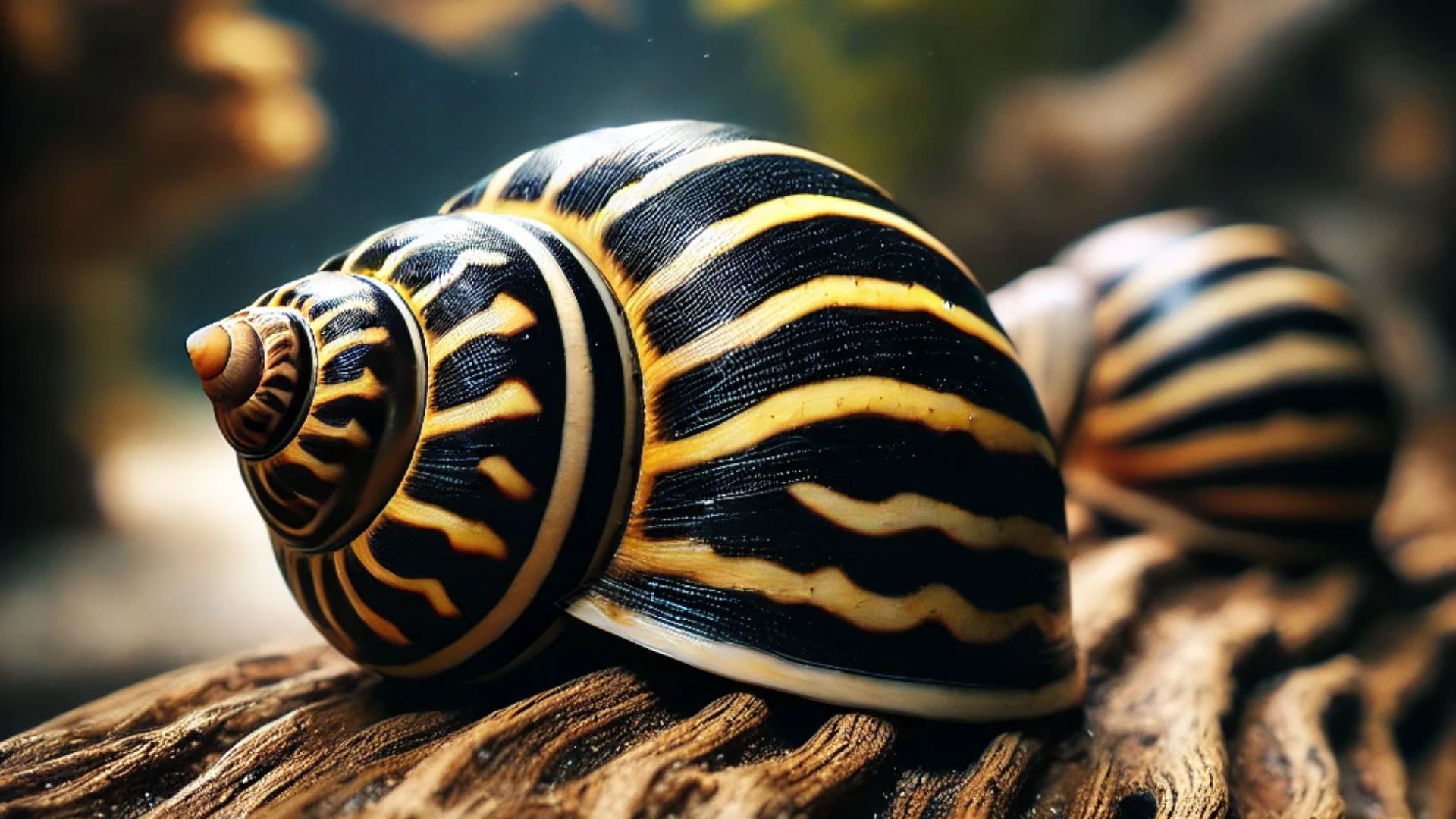
Nerite Snail
Scientific name: Various species within the family Neritidae, including Neritina natalensis, Neritina reclivata, Clithon corona, among others.
Nerite Snails are popular freshwater and brackish water snails known for their attractive shell patterns and exceptional algae-eating abilities.
Native to coastal and riverine habitats across Africa, Asia, and the Americas, these snails are valued in the aquarium hobby for their ability to help keep tanks clean by consuming various types of algae.
Their shells come in a variety of colors and patterns, including stripes, spots, and horn-like projections, making them an aesthetically pleasing addition to aquariums.
IUCN Red List of Threatened Species : Varies by species; generally not evaluated or listed as Least Concern
Nerite Snails are hardy and adaptable, making them suitable for both beginners and experienced aquarists. They thrive in tanks with plenty of surfaces to graze on, such as rocks, driftwood, and live plants. Being peaceful creatures, they can be kept with a wide variety of tank mates. Since they cannot reproduce in freshwater, there is no risk of them overrunning the tank with offspring.
They are herbivores that primarily feed on algae, biofilm, and decaying plant matter. Supplementing their diet with algae wafers or blanched vegetables like zucchini and spinach ensures they receive adequate nutrition, especially in tanks with minimal algae growth.

Navite Location
Africa, Asia, the Americas, and other tropical regions / Habitats include rivers, streams, estuaries, and coastal waters
Varieties
Zebra / Tiger / Olive / Horned / Red Racer / Ruby
Suggested Tank Mates
Tetras (Neon Tetras, Cardinal Tetras) / Guppies / Mollies / Platies / Corydoras Catfish / Shrimp (Amano Shrimp, Cherry Shrimp) / Other peaceful community fish
Tank Mates to Avoid
Aggressive or predatory fish / Loaches (some species may prey on snails) / Pufferfish / Crayfish and larger shrimp species / Large Cichlids / Any species known to eat or harass snails
Diet
Algae (green spot algae, soft film algae) / Biofilm on tank surfaces / Blanched vegetables (zucchini, cucumber, spinach) / Algae wafers and sinking pellets / Avoid overfeeding to maintain water quality
Breeding
Nerite Snails may lay small, white eggs in freshwater aquariums, often on hard surfaces like glass, rocks, and decorations. However, these eggs will not hatch in freshwater conditions because they require brackish or saltwater to develop. Breeding Nerite Snails in captivity is challenging and typically requires replicating brackish water conditions.
Lifespan
1 to 2 years with proper care
Size
Up to 2.5 cm (1 inch) in diameter
Minimum Tank Size
10 gallons (38 liters); larger tanks provide more stable water conditions and ample grazing surfaces
Optimum Tank Temperature
22°C to 28°C (72°F to 82°F)
Ideal pH Level
7.5 to 8.5 (slightly alkaline water preferred)
Water Hardness
6 – 12 dGH (moderately hard water)
Common Health Issues
Shell Erosion or Pitting due to soft or acidic water / Injury from falls or sharp objects in the tank / Starvation if insufficient algae or food sources are available / Sensitivity to copper and certain medications / Escape attempts indicating poor water quality
Interesting facts
Cannot Reproduce in Freshwater
Nerite Snail eggs require brackish or saltwater to hatch, so they won’t overpopulate freshwater tanks, making them ideal for algae control without the risk of infestation.
Algae Control Experts
They are among the most effective algae-eating snails, consuming a variety of algae types, including those that other species may ignore, such as green spot algae.
Variety of Patterns
Their shells exhibit diverse patterns and colors, from zebra stripes to horn-like projections, adding unique visual interest to aquariums.
Escape Artists
Nerite Snails can climb out of tanks if the water conditions are not ideal or if there is insufficient food. A tight-fitting lid is recommended to prevent escapes.
Shell Growth Rings
Similar to trees, some Nerite Snails exhibit growth rings on their shells, which can give an indication of their age and growth rate.
Nerite Snail FAQ’s
Do Nerite Snails Eat Live Plants?
Generally, Nerite Snails do not eat healthy live plants. They prefer algae and biofilm. However, they may consume decaying plant matter and algae growing on plant leaves.
Can Nerite Snails Escape from the Tank?
Yes, Nerite Snails are capable climbers and may attempt to escape if water conditions are poor or if they are searching for food. Using a tight-fitting lid and maintaining good water quality can prevent escapes.
What do Nerite Snails Eat?
Nerite Snails are herbivores known for their voracious appetite for algae, making them excellent natural cleaners for your aquarium. Their primary diet consists of:
- Algae: They consume various types of algae, including green spot algae, soft film algae, brown algae (diatoms), and hair algae. They scrape these off surfaces like glass, rocks, driftwood, and plant leaves using their specialized mouthparts.
- Biofilm: This is a thin layer of bacteria, microorganisms, and detritus that accumulates on surfaces within the tank. Nerite Snails feed on biofilm, helping to keep the tank clean.
- Blanched Vegetables: If natural algae sources are insufficient, you can supplement their diet with blanched vegetables such as zucchini, cucumber, spinach, or lettuce. Slice the vegetables thinly and secure them near the tank bottom for easy access.
- Algae Wafers and Sinking Pellets: Commercial algae wafers or sinking pellets formulated for herbivorous invertebrates can be offered to ensure they receive adequate nutrition.
Feeding Tips:
- Monitor Algae Levels: Ensure there is enough natural algae in the tank for your snails to feed on. In tanks with minimal algae growth, regular dietary supplementation is necessary to prevent starvation.
- Avoid Overfeeding: Excess uneaten food can degrade water quality, leading to health issues for your snails and other tank inhabitants. Offer small amounts and remove any uneaten food after 24 hours.
- Calcium Intake: While not a direct food source, adequate calcium in the water is essential for shell health. You can provide cuttlebone or calcium-rich vegetables to help maintain strong shells.
- Do Not Rely Solely on Algae Wafers: While convenient, algae wafers should not be the sole food source. A varied diet ensures better health and mimics their natural feeding habits.
What They Do Not Eat:
- Live Plants: Nerite Snails generally do not eat healthy live plants, making them safe for planted aquariums. They may, however, consume dead or decaying plant matter.
- Meaty Foods: They are not equipped to process proteins from animal sources and should not be fed fish flakes or pellets intended for carnivorous species.
How Do You Breed Nerite Snails?
Breeding Nerite Snails in captivity is challenging due to their unique life cycle, which requires both freshwater and brackish water environments. Here’s a concise guide:
- Understand Their Reproduction Needs:
- Egg Laying in Freshwater: Nerite Snails lay eggs in freshwater tanks, but the eggs won’t hatch in these conditions.
- Brackish Water for Development: The eggs require brackish water (a mix of freshwater and saltwater) to hatch and for larvae to develop.
- Set Up a Brackish Breeding Tank:
- Tank Size: A small tank of about 10 gallons (38 liters) is sufficient.
- Salinity: Adjust salinity to a specific gravity (SG) of 1.005 to 1.010 using marine aquarium salt.
- Temperature: Maintain between 24°C to 27°C (75°F to 80°F).
- pH Level: Keep pH between 7.5 and 8.5.
- Filtration: Use a gentle sponge filter to protect tiny larvae.
- Transfer Adult Snails:
- Acclimate Slowly: Gradually introduce adult Nerite Snails to the brackish tank over several hours to prevent shock.
- Encourage Egg Laying:
- Provide Surfaces: Include rocks, driftwood, or other hard surfaces for egg deposition.
- Adequate Diet: Offer plenty of algae, biofilm, and supplemental foods like blanched vegetables to stimulate reproduction.
- Care for Eggs and Larvae:
- Hatching Time: Eggs may take several weeks to hatch.
- Feeding Larvae: Larvae are microscopic and feed on phytoplankton or specialized liquid fry foods.
- Water Quality: Maintain excellent water conditions; perform gentle water changes to avoid stressing larvae.
- Transition Juveniles to Freshwater:
- Gradual Salinity Reduction: Once larvae develop into juvenile snails, slowly decrease salinity over several days to acclimate them to freshwater conditions.
- Important Considerations:
- Patience Required: The breeding process can be time-consuming with a low survival rate.
- Avoid Predators: Keep the breeding tank free of fish or other organisms that might eat the eggs or larvae.
- Monitor Closely: Regularly check water parameters and snail health throughout the process.
Note: Due to the complexity and specific conditions required, many hobbyists opt to purchase additional Nerite Snails rather than breeding them. Breeding them can be a rewarding project for experienced aquarists interested in a challenge.
